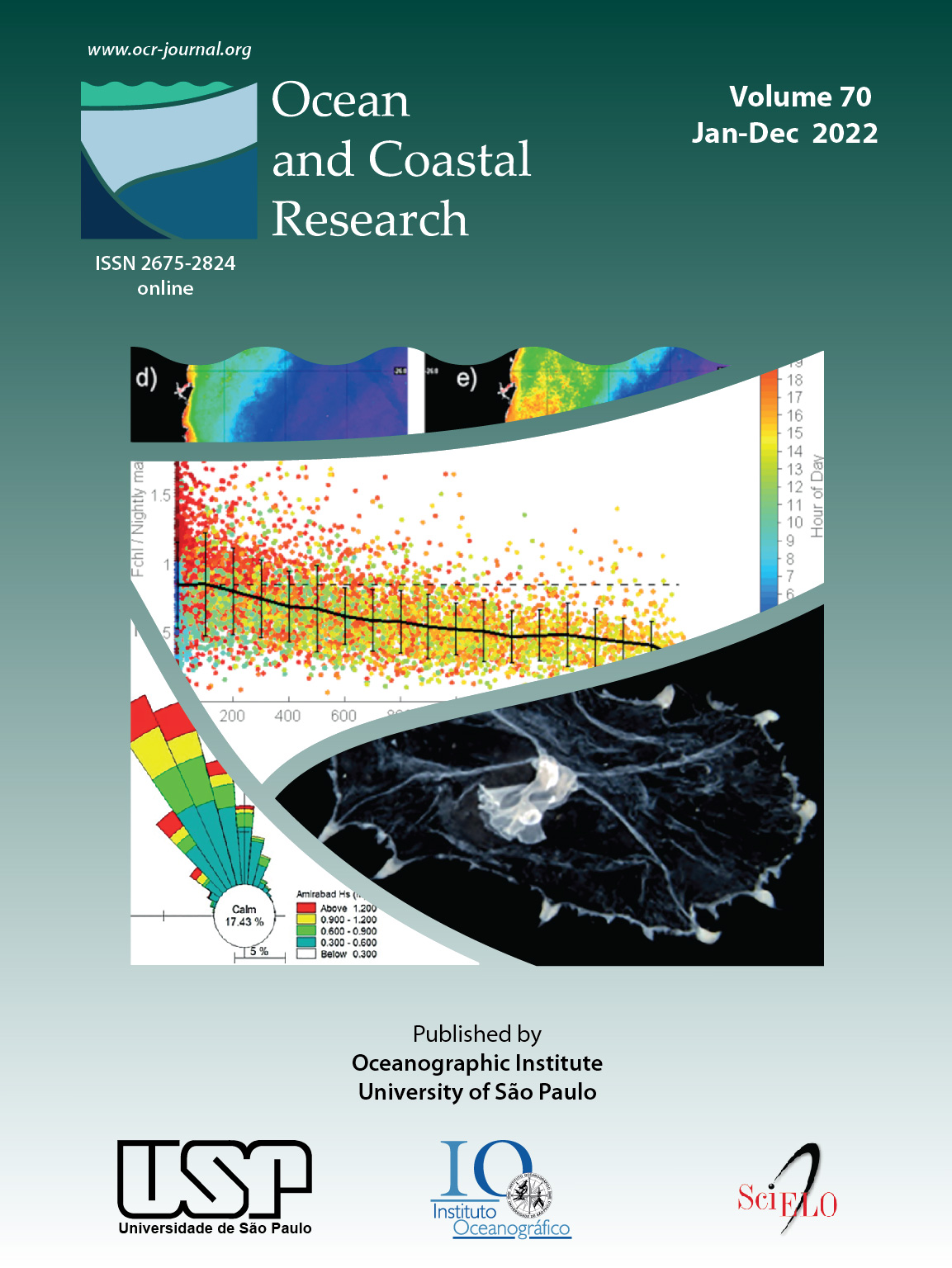Shark species identification from bite marks on a Short-finned Pilot Whale, Globicephala macrorhynchus
DOI:
https://doi.org/10.1590/Keywords:
Galeocerdo cuvier, Bite wounds, Cetacean, PredationAbstract
A Short-finned Pilot Whale, Globicephala macrorhynchus, was found dead and with shark bites along its body on a beach in northeast Brazil. The present study aimed to identify the shark species responsible for the bites as well as to estimate its/their total length. Species identification was performed using the bite marks, which were of the same diameter, suggesting they were infected by one or more Tiger sharks of similar size. The characteristics of the bites and the shape and distribution of the marks left by the teeth pointed to the Tiger Shark, Galeocerdo cuvier. The total length of the Tiger Shark or sharks was estimated at between 257 and 288 cm, based on the perimeter contour of each bite and the interdental distance inferred from the marks on the whale. This suggests that the bites were inflicted by one or more sub-adult specimens.
References
BORNATOWSKI, H., WEDEKIN, L. L., HEITHAUS, M. R., MARCONDES, M. C. C. & ROSSI-SANTOS, M. R. 2012. Shark scavenging and predation on cetaceans at Abrolhos Bank, eastern Brazil. Journal of the Marine Biological Association of the United Kingdom, 92(8), 1767-1772, DOI: https://doi.org/10.1017/S0025315412001154
» https://doi.org/10.1017/S0025315412001154
CLUA, E., BESCOND, P. M. & REID, D. 2014. Fatal attack by a juvenile tiger shark, Galeocerdo cuvier, on a kite-surfer in New Caledonia (South Pacific). Journal of Forensic and Legal Medicine, 25, 67-70, DOI: https://doi.org/10.1016/j.jfm.2014.04.005
» https://doi.org/10.1016/j.jfm.2014.04.005
CLUA, E., CHAUVET, C., READ, T., WERRY, J. M. & LEE, S. Y. 2013. Behavioural patterns of a tiger shark (Galeocerdo cuvier) feeding aggregation at a blue whale carcass in Prony Bay, New Caledonia. Marine and Freshwater Behaviour and Physiology, 46(1), 1-20, DOI: https://doi.org/10.1080/10236244.2013.773127
» https://doi.org/10.1080/10236244.2013.773127
CLUA, E. & REID, D. 2018. Contribution of forensic analysis to shark profiling following fatal attacks on humans. In: DOGAN, K. H. (eds.). Post mortem examination and autopsy - current issues from death to laboratory analysis London: Intech, pp. 57-75.
HEITHAUS, M. R. 2001a. Shark attacks on bottlenose dolphins (Tursiops aduncus) in Shark bay, western Australia: Attack rate, bite scar frequencies, and attack seaso-nality. Marine Mammal Science, 17(3), 526-539, DOI: https://doi.org/10.1111/j.1748-7692.2001.tb01002.x
» https://doi.org/10.1111/j.1748-7692.2001.tb01002.x
HEITHAUS, M. R. 2001b. Predator-prey and competitive interactions between sharks (order Selachii) and dolphins (suborder Odontoceti): a review. Journal of Zoology, 253(1), 53-68, DOI: http://dx.doi.org/10.1017/s0952836901000061
» http://dx.doi.org/10.1017/s0952836901000061
JEFFERSON, T., WEBBER, M. & PITMAN, R. 2015. Short-finned pilot whale. In: WEBBER, M. A., JEFFERSON, T. A. & PITMAN, R. (eds.). Marine mammals of the world: a comprehensive guide to their identification. 2nd ed. Cambridge: Academic Press, pp. 193-196.
JUCÁ-QUEIROZ, B., NETO, J. S., MEDEIROS, R. S., NASCIMENTO, F. C., FURTADO-NETO, M. A. D. A., FARIA, V. V. & RINCON, G. 2008. Cartilaginous fishes (class Chondrichthyes) of Ceará state, Brazil, Western Equatorial Atlantic - an update. Arquivos de Ciências do Mar, 41(2), 73-81.
LONG, D. & JONES, R. 1996. White shark predation and scavenging on cetaceans in the eastern North Pacific Ocean. In: KLIMLEY, A. P. & AINLEY, D. (eds.). Great White Sharks: the biology of Carcharodon Carcharias. Cambridge: Academic Press, pp. 293-307.
LOWRY, D., CASTRO, A. L. F., MARA, K., WHITENACK, L. B., DELIUS, B., BURGESS, G. H. & MOTTA, P. 2009. Determining shark size from forensic analysis of bite damage. Marine Biology, 156, 2483-2492, DOI: https://doi.org/10.1007/s00227-009-1273-3
» https://doi.org/10.1007/s00227-009-1273-3
NAESSIG, P. J. & LANYON, J. M. 2004. Levels and probable origin of predatory scarring on humpback whales (Megaptera novaeangliae) in east Australian waters. Wildlife Research, 31(2), 163-170, DOI: https://doi.org/10.1071/WR03086
» https://doi.org/10.1071/WR03086
OSLON, P. A. 2009. Pilot whales. In: WURSIG, B., THEWISSEN, J. G. M. & KOVACS, K. (eds.). Encyclopedia of marine mammals 3rd ed. Cambridge: Academic Press, pp. 847-852.
TUCKER, J. P., VERCOE, B., SANTOS, I. R., DUJMOVIC, M. & BUTCHER, P. A. 2019. Whale carcass scavenging by sharks. Global Ecology and Conservation, 19, e00655, DOI: https://doi.org/10.1016/j.gecco.2019.e00655
» https://doi.org/10.1016/j.gecco.2019.e00655
WELLER, D. W. 2009. Predation on marine mammals. In: WURSIG, B., THEWISSEN, J. G. M. & KOVACS, K. (eds.). Encyclopedia of marine mammals 3rd ed. Cambridge: Academic Press, pp. 923-932.
WHITNEY, N. M. & CROW, G. L. 2006. Reproductive biology of the tiger shark (Galeocerdo cuvier) in Hawaii. Marine Biology, 151, 63-70, DOI: https://doi.org/10.1007/S00227-006-0476-0


